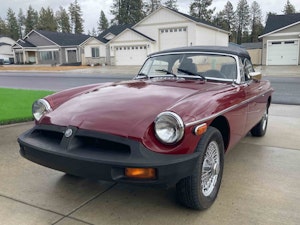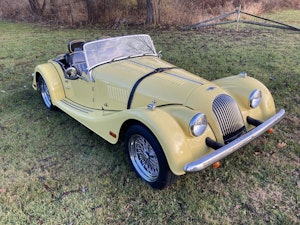Media | Articles
Old and New: Musings on a Pair of Nissan Pickups
If Nissan had built cars in the 14th century, I have no doubt that the theologian William of Ockham would have been first in line for this 1983 720 GL Long Bed pickup. The math doesn’t work, obviously, and by all accounts he failed his driving test, but his lasting philosophical nugget still rings true: “The simplest explanation is usually the best one.”

There has never been a simpler explanation for a pickup truck than this thing. Especially when it’s parked beside its entirely elaborate kin, the Frontier Pro-4X. That this particular two-wheel-drive 720 happens to be the very first vehicle to roll off of Nissan’s Smyrna, Tennessee, production line—Job 1, as they say, built June 16, 1983—is just a pleasant bonus.
Nissan North America was kind enough to let me drive it, and the Frontier, on a recent event that paired a trio of past and present vehicles from the company’s catalog, and the white 720 was my first stint of the day. The odometer read a simple three digits—755—when I got in and turned the key.

And as 103 horses neighed and 104 feet pounded while the little 2.4-liter twin-spark four-cylinder warmed up on the roof of the parking deck at Nissan HQ, I took stock of “The Tennessee Special,” as PR man Jonathan Buhler referred to it: immaculate blue vinyl bench seat; manual windows and locks; radio delete; A/C delete; horn and hazards delete (from age, one suspects, not from the factory); a rearview mirror but no side mirrors—though I would later discover the dealer-optional driver’s mirror in the glovebox, along with its mounting hardware, still packaged; and a hard plastic dash punctuated, almost ostentatiously given the circumstances, by a shiny thin strip of brown plastic wood veneer.




To stand and look at the Nissan, you first notice the condition. It’s so clean. Then you realize just how small it is by today’s standards—and not only compared to small pickups, but to everything. A new Maxima could eat this thing where it sits on its cute little beauty-ringed 14-inch steel wheels. The seven-foot-long bed is almost too long, bordering on the comical, like maybe it’s really 12 feet, somehow. I didn’t try it, but I bet you could fit the entire truck in there, though it would likely exceed max payload.
Marketplace
Buy and sell classics with confidence

On the road, this thing is no get-up-and-goer. Rather, it is an ambler of the first sort. The thin blue steering wheel feels light and requires zero muscle. In fact, nothing works very hard, just very well, and it is perfect for slow-cruising the meandering two-lanes that wend their way through the countryside southeast from Franklin. Roll the window down, stick an arm out, go. Even with windows up, however, I noted that it still sounds like they are down, such was the state of sound deadening in austere imports back in June ’83. Seriously, for the first 10 minutes or so, I really thought I’d left a door open.
With each vehicle change throughout the day, the other journalists who hopped out of the 720 all agreed: The little truck was delightful, a fan favorite. The 720 was Nissan’s base-model truck, and one so equipped would have cost about $3000 back in ’83. The fact that you see so few of them on the road today is an unfortunate testament to their general rode-hard-and-put-away-wet disposability back then. There’s a small but passionate fanbase out there for old Datsun trucks, however, particularly the 520 and 620 series of the 1970s. There are exceptions, of course, but you’d be hard pressed to find any vintage Datsun pickup selling for much more than about $10,000, even in great shape.
A vehicle unremarkable in period tends to translate to cheap and accessible today, which is good news for fans of frugality—and 14th century philosophers.



Standing in stark contrast to its long, low forebear is the Frontier Pro-4X, a $42,000 beefcake in Afterburn Orange. The Frontier nameplate has been with us since 1997, when it succeeded the popular Hardbody, which was preceded by the 720 above.
If you squint, you could make the argument that this newest, brawniest Frontier is remarkably similar in its sneer and many sharp angles to its chief competitors, the Toyota Tacoma TRD Off-Road and the Chevy Colorado Trail Boss. Badge-swapping the three would likely go unnoticed by enormous swaths of the population.

To be fair, though, the Frontier does lack some of the exterior fussiness of the other two, particularly up front, and it certainly looks capable, not that I actually put it to the test off-pavement, which is probably pretty true to the actual use it will get in the hands of 95 percent of its owners. But its Bilstein suspension, locking rear differential, underbody skidplates, 9.5-inch clearance, 32-degree approach angle, and a plethora of “Oh shit!” handles all speak to those off-road chops. The 310-hp, 3.8-liter V-6 packs a punch and the nine-speed automatic, well, it shifts forever—three times as much as the auto box in the 720, anyway.




The interior, like all new-car interiors of a certain ilk, feels lux, with a big power sunroof, no shortage of touchscreen real estate, various cameras, nannies that bing and bong at you, wireless device charging, auto stop-start, seat and steering wheel heaters, and lots of black leather punctuated by red stitching. There’s plenty of sound deadening, too; not once did I think I’d left a door open.
Besides being a lot more orange, next to the 720, the Frontier’s cab is longer, its bed shorter, and it stands about six times as tall. You feel that, of course, out on the road as you tower over lesser traffic to the extent that “aerial command” should probably be advertised as a standard feature. (Newness aside, the Pro-4X trim isn’t exactly comparable to the bare-bones 720 GL; today’s comp would be the base S trim.)



To say that the Frontier Pro-4X and the 720 are cut from the same cloth is both true and false at once. They are Nissan pickup trucks, true. But the passage of time and the passing of laws and the passé of simplicity for its own sake have ushered today’s version down a different, more complicated path. Which only serves to reinforce just how wonderful it is to have the old version out there, ambling the backroads of America, the perfect explanation of a pickup truck.


























































We truly have lost our way in terms of economy, repairability and much practicality. The Frontier’s bed looks comically chopped and I find today’s short beds to be no better than a trunk without a lid. We need a return to basics, but I recognize it’s unlikely to happen.
My biggest beef is you can’t get a long bed on any half ton fullsize crew cab truck now.
As a 3rd gen Tacoma owner I will say these new Nissan trucks are pretty sharp
Like most auto manufacturers, Nissan forgot what made them great. They traded technology add-ons (profit) for reliability and quality. Suburu and Toyota seem to be the only manufacturers who are consistent with their original vision. If you want an inexpensive car, you have to look to Korean brands that simply don’t hold up versus their Japanese competition.
Suggestion: Offer a small truck(again) to compete with the Ford Maverick – and make an SUV version (like the first gen Explorer or 4Runner). Just returned from Brazil – both Chevy and RAM have a small truck sold here – ? Big trucks are dinosaurs unless you actually use them as intended. They are the new “land yacht” – that ship has sailed.
So longing for a smaller regular cab pickup with a longer bed. 4 foot and 5 foot beds with 4 door cabs just don’t do it for me.